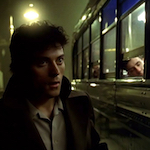 One night an amnesiac (Rufus Sewell, EXTREME OPS, JUDY) wakes up confused in the bath tub of a gloomy hotel in a gloomy city. The phone rings and some Peter-Lorre-sounding weirdy (Kiefer Sutherland, RENEGADES, MIRRORS) tells him he needs to get out of there because someone’s coming for him. Then he notices the dead lady with the spirals carved into her. Shit!
One night an amnesiac (Rufus Sewell, EXTREME OPS, JUDY) wakes up confused in the bath tub of a gloomy hotel in a gloomy city. The phone rings and some Peter-Lorre-sounding weirdy (Kiefer Sutherland, RENEGADES, MIRRORS) tells him he needs to get out of there because someone’s coming for him. Then he notices the dead lady with the spirals carved into her. Shit!
In the tradition of such films as FEAR IN THE NIGHT (1947) and NIGHTBREED (1990), Murdoch is unsure if he’s really a murderer. But we’ve seen stories like this before, so we figure he’s not. And it’s pretty clear that something unusual is going on here when the people the guy on the phone was warning about show up. They’re not cops, but “The Strangers,” a group of mysterious, pale, bald dudes in black coats and fedoras like a gang of Detective Nosferatus. They move strangely, have odd facial expressions and are a range of heights that make them look interesting walking around together. I’ll try to list them from tallest to shortest:
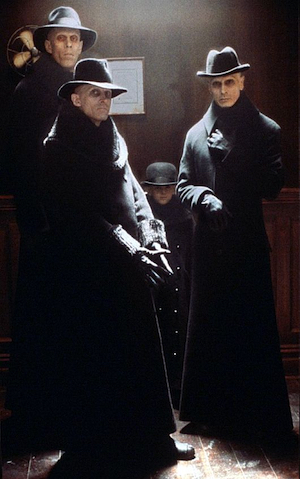 Mr. Wall (the great Bruce Spence of ROAD WARRIOR, REVENGE OF THE SITH and THE MATRIX REVOLUTIONS)
Mr. Wall (the great Bruce Spence of ROAD WARRIOR, REVENGE OF THE SITH and THE MATRIX REVOLUTIONS)
Mr. Hand (Richard O’Brien, Riff Raff from THE ROCKY HORROR PICTURE SHOW)
Mr. Book (Ian Richardson, BRAZIL)
and
Mr. Sleep (played alternately by young twins Satya & Noah Gumbert).
So this amnesiac probable-non-murderer tries to figure out who the fuck he is by getting his name, John Murdoch, from his ID and following a series of clues to his estranged wife Emma (Jennifer Connelly, PHENOMENA), meanwhile hiding from The Strangers and the actual cops, specifically Detective Bumstead (William Hurt, BODY HEAT), whose search for a serial killer is hampered by the last guy on the case, Walenski (Colin Friels – Strack from DARKMAN) having had one of those covering-the-walls-in-collages-and-cryptic-graffiti type breakdowns over it. Murdoch also meets the guy from the phone, Dr. Schreber, who we also see having cryptic, threatening visits from the Strangers while he floats in a swimming pool.
Schreber gives Murdoch some information, he begins to become paranoid about the nature of reality and attempts to recruit his wife and the detective into his skepticism. In a TRUMAN SHOW-like touch, he tries to go to a place called Shell Beach but can never seem to make it there, and whenever he asks people for directions they think it’s easy but as soon as they start talking they get hung up and can’t remember. Worse, he gets people to realize that they can’t remember the last time it was daytime. It’s just always dark in this city. Terrible for people who use solar panels or suffer from seasonal affective disorder, though great for goths.
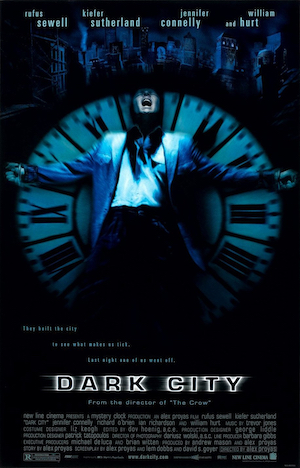
All of this is intriguing, but it’s the Strangers who are one of the great cinematic inventions of their era, and who provide for the most interesting encounters. I like how li’l Mr. Sleep chatters at Murdoch like a Cenobite, or like the killer dolls in BARBARELLA, and viciously bites his hand. As he gets chased across buildings and ledges Murdoch starts to realize that he has SCANNERS type mental powers to fight them off with. Best of all, he spies on them coming in and out of appearing and disappearing doors, up to strange doings he can’t quite discern.
I’m sure you all know what the solution to the mystery is here, but if not this is a SPOILER. At least for the director’s cut (more on that later). Schreber eventually reveals that The Strangers are corpses possessed by extra-terrestrials, and everyone else is a guinea pig in their experiment to understand humanity. People don’t remember daylight because they’ve never seen it – their memories are implanted, and the city is actually floating in space. Every night the Strangers use hypnotic powers to make all the humans fall asleep and then they go around “tuning” – altering buildings, moving people around in their sleep and giving them different lives, just to see what happens. Schreber is a scientist forced to work with them because he knows how to create false memories, which he literally injects into them. And Murdoch is an anomaly who woke up before he could be injected with the memories of being a murderer.
This is very much a short story or Twilight Zone type of premise, intentionally fantastical and not aiming for realism (because realism is overrated). It’s about surreal images like a round circle of city floating in space, or situations like being the one person who’s awake, seeing the whole city fall asleep in traffic, at work, at the dinner table. Or going down a rollercoaster-like freight elevator to the hidden underworld where the hive-minded Strangers, looking even more like Cenobites without their hats, meet around a giant clock. They have a Santa’s Workshop type operation with a conveyor belt, where they prepare fake journals and mementos and stuff to give to people to represent their fake pasts. Which explains Detective Bumstead carting around a fancy accordion that he says belonged to his mother.
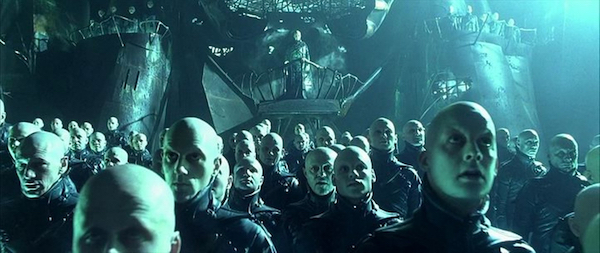
And it’s got one of those great reveal sequences – sorta like when we see the aliens going about their business in THEY LIVE – where we first see them doing their nightly tuning. They make buildings grow and shrink, which I believe the filmmakers achieved by filming miniature models and then digitally warping them. We see them grow a working class couple’s home into a mansion, stretch out their dinner table to some Bruce Wayne shit, give them a whole different existence. That has some philosophical grist to it I think, the idea that the exact same people change depending on the resources that are given or taken from them. And there’s some musing on the question that UNIVERSAL SOLDIER: DAY OF RECKONING later explored of whether or not we are just the sum of our memories, and therefore if it matters whether or not the things we remember really happened.
I’d never heard of an automat (like a cross between a diner and a vending machine) when I first saw this so I thought it was made up. The mechanical inhumanity of the place is just one image that foreshadows the role humans serve for the Strangers. There are also many looks at goldfish in bowls or aquariums, a mouse in a maze, and mannequins in windows acting out the part that someone dressed them up for.
There are many cool gimmicks in this story. Mr. Hand is injected with the memories Murdoch was supposed to get so that he can get into his mind, so he ends up being a psycho. Murdoch and Bumstead dig through a brick wall they think leads to Shell Beach and instead find they’re on the edge of the city looking out into space. And I think the coolest one is when Schreber defeats the Strangers because he’s supposed to inject Murdoch with the collective memories of the Strangers but instead has prepared memories of being taught to use his tuning powers since childhood. So with one injection he gives Murdoch decades of training, which we see in sort of the form of “your life flashing in front of your eyes”, with Schreber appearing to him as the mailman and other characters, giving him advice across the years. So cool.
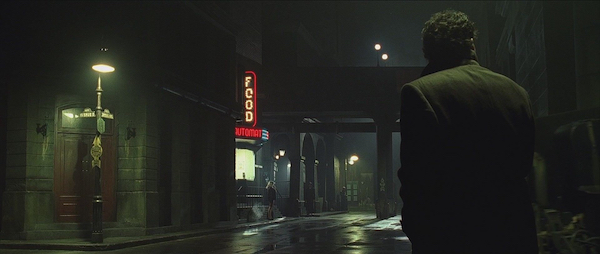
DARK CITY was a pretty natural evolution for director Alex Proyas after THE CROW. He’d been working on the script since before filming THE CROW, and capitalized on that film’s success to get it made. (In those days directors could cash in to get weird personal projects made, not just to get a high profile intellectual property gig.) DARK CITY ditches the action context of the other film but goes even further into creating a foreboding artificial world – streets built on sound stages, miniature models, composited skies. The mixed elements of the past and present are not just a cool style anymore – now that’s organic to the premise. This world evokes every time period and no time period because the Strangers created it from a mixture of stolen memories. Proyas filmed all but the last scene on soundstages, without contemporary cars or other evidence of when it was made. There’s nothing in the way of fashion to date it, no pop culture references, I guess there’s an Echo and the Bunnymen song at the end of the credits, but otherwise the only songs are Jennifer Connelly’s torch singer character performing standards in a night club.
You may notice that the occasional digital effects, which at the time were very innovative, now don’t seem like much (even after being adjusted for the director’s cut). Still, I think most people who come across it now without having heard of it would have a hard time pinpointing exactly when it was made.
At least from the surface. When you look at it a little closer it is so very 1998, because it’s part of a slew of movies about living in constructed realities, including THE TRUMAN SHOW (1998), THE THIRTEENTH FLOOR (1999), EXISTENZ (1999), and of course THE MATRIX (1999). That was clearly something that was in the air, in the ether, in the zeitgeist.
THE MATRIX was made too close to DARK CITY to have been very influenced by it, and most of the things we love about the latter are not in the former. DARK CITY doesn’t have kung fu (or any fighting, really), there are no computers, no techno music. But it does have an adrift everyman protagonist who senses something weird going on, gets a phone call from a mysterious person who warns him otherworldly beings are about to come after him, and soon learns that he’s living in a false reality, that there is no longer sunlight, that no one knows how long ago the “real world” existed, and that he has unique powers that he can cultivate and become a threat to humanity’s secret overlords. Even the “lifetime of memories in a single syringe” could be compared to the “I know kung fu” downloads Neo receives.
And that’s not all! Both take heavy visual influence from noir, and THE MATRIX’s early scenes take place in a city very reminiscent of the one in DARK CITY, with similar images like looking down a spiraling staircase with tile floors. In fact, it might be the same staircase. Filming on the same soundstages at Fox Studios Australia, the MATRIX production actually repurposed some of DARK CITY’s sets of rooftops, building interiors and streets. I’m pretty sure the phone booth Dr. Schreber calls him from is the same one Trinity escapes into.
But one big advantage THE MATRIX had was that the studio was convinced to stay out of the way and trust in the Wachowskis. DARK CITY, unfortunately, did not have that luxury. Can you imagine if the first time you saw THE MATRIX, instead of spending that first act wondering who Trinity and Morpheus are and what’s going on with Neo until he finally meets Morpheus, takes the red pill and gets that explanation of what The Matrix is… they just dumped narration over the opening scene where Morpheus says machines took over the world and plugged people’s brains into virtual reality and they’re rebels fighting against agents to try to free everybody’s minds? And then you go ahead and watch Neo not knowing this for a while and then Morpheus makes the speech about it? That’s exactly how we first had to experience DARK CITY when it played in theaters. Dr. Schreber explains the whole premise of the Strangers and what they do. Then we proceed to watch as this mystery unfolds, leading to what was clearly meant as the big reveal.
It’s just such an astoundingly stupid movie sabotage it’s hard to imagine human beings going through with it. It’s not only a matter of not respecting the vision, it’s not respecting the way stories are told! It’s just infuriating. I’ve never seen the decision ascribed to a specific individual, only to pressure from New Line Cinema, backed with findings from test screenings. That might mean Michael De Luca, who I believe was in charge at the time, but you wouldn’t expect that from the guy who wrote IN THE MOUTH OF MADNESS a few years earlier. Whoever is responsible, I hope they have since gone off to live in the jungle and find repentance by traveling around doing menial work in small villages, but if not they should be infamous.
Thankfully ten years later Proyas was allowed to reconstruct a director’s cut for DVD and blu-ray. It’s about 15 minutes longer, but really the big thing is just getting rid of that fucking narration. Another thing I don’t remember knowing at the time is that they dubbed Connelly’s three songs with singer Anita Kelsey. That’s a normal thing to do, but the director’s cut restores Connelly’s singing, and she does great! Nothing against Kelsey, but using Connelly’s actual voice is obviously better. I wonder if the person who insisted on that is the same one who came up with the narration idea, or if they’re some other idiot lucky enough to have even worse meddling they can point to as not their fault.
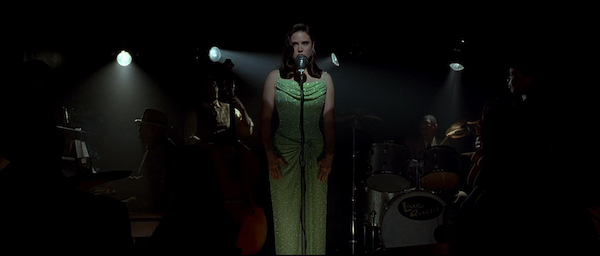
Other sci-fi movies of 1998 include GODZILLA, ARMAGEDDON, DEEP IMPACT, SPHERE, LOST IN SPACE, THE X-FILES, DISTURBING BEHAVIOR and SPECIES II, so I think it’s fair to say this one stands out from the crowd. Maybe the one it has the most in common with is THE TRUMAN SHOW, but that’s all thematic, not style or tone. DARK CITY was honored with “Best Science Fiction Film” at the 1998 Saturn Awards… tied with ARMAGEDDON, though. It was also nominated for best costumes, director, make-up, special effects and writer (losing to EVER AFTER, ARMAGEDDON, VAMPIRES, GODZILLA and THE TRUMAN SHOW, respectively).
DARK CITY was not a hit in theaters, basically just making back its production budget at the box office, but it got some great reviews. Roger Ebert called it the best film of 1998 (topping SAVING PRIVATE RYAN and LIFE IS BEAUTIFUL, among others), later dissected it scene-by-scene in a lecture and provided a DVD commentary track. And I think it has been consistently appreciated at least in a cult film capacity ever since it was released. It has not had the same impact as THE MATRIX, and that’s okay. There are many reasons for that and one of them, honestly, is that it’s just not as applicable to our lives. The idea of our world being used to distract us from a system using us as fodder hits a little closer to home than it being an experiment for aliens to understand the human soul, and the latter doesn’t come up as much in conversation.
So by design it’s a very different experience. It uses similar influences and feelings of paranoia but in a much more expressionistic way. It’s about dropping us into a creepy, oppressive world and not letting us breathe until the very end. At the time the look reminded me of Jean-Pierre Jeunet & Marc Caro’s THE CITY OF LOST CHILDREN and Terry Gilliam’s BRAZIL, and those are high compliments. I don’t know if it’s green screens replacing soundstages, or big budget movies not being allowed to be as weird, or the dearth of mid-budget movies, or what, but it seems like these days we don’t get as many of these movies that are all about production design and style like we did in the days when Burton and Gilliam and some of those guys were huge. I would say Wes Anderson does a version of it (and gets tiresomely made fun of for it by joyless Twitterers who see having a distinct style as an affront to their flavorless existences) but we don’t see it as much in genre films.
I have found this to be a controversial statement, but IN MY OPINION ONLY, film is a visual medium, and there should be more movies that look really cool. And I feel that “style over substance” is often an empty criticism. It ignores that beauty, atmosphere and mood are at least as crucial to the expressive powers of film as plot mechanics are. In other words, sometimes style is substance. Also, people tend to be way harder on “style over substance” than on the status quo of having neither style or substance.
The credited production designers are George Liddle (RAPA NUI) and Patrick Tatopoulos, who is maybe a genius considering his work on this, BRAM STOKER’S DRACULA, SE7EN, and SILENT HILL, but also worked on some of the most butt-ass ugly movies of the ‘90s including LAWNMOWER MAN 2: JOBE’S WAR BEYOND CYBERSPACE and SPAWN. He will forever be most associated with Emmerich’s GODZILLA, since its main character took his surname, a fitting curse for the person who decided Godzilla should look like his pet monitor lizard instead of like Godzilla. Still, I will always admire him for this one.
I’ve always figured one of the keys to the movie’s power is cinematographer Dariusz Wolski, who came from music videos (including Paula Abdul’s “Forever Your Girl”) before becoming a go-to guy for visualist directors like Proyas (THE CROW), Tony Scott (CRIMSON TIDE, THE FAN), Andrew Davis (A PERFECT MURDER), Gore Verbinski (THE MEXICAN, PIRATES OF THE CARRIBEAN trilogy), Tim Burton (SWEENEY TODD, ALICE IN WONDERLAND) and Ridley Scott (PROMETHEUS, THE COUNSELOR, EXODUS: GODS AND KINGS, THE MARTIAN, ALIEN: COVENANT, ALL THE MONEY IN THE WORLD, THE LAST DUEL, HOUSE OF GUCCI). Weirdly, Wolski’s first feature was NIGHTFALL (1988), which is about a world where it’s always daytime.
Proyas wrote the script with Lem Dobbs (after THE HARD WAY and KAFKA, before THE LIMEY) and once he got a bigger budget he brought on David S. Goyer to write more scenes with the Strangers using their powers and stuff. He chose Goyer based on the screenplay for BLADE (at that time unproduced). It’s kinda weird that Goyer had also sequelized one of Proyas’ movies with THE CROW: CITY OF ANGELS. I wonder what kind of conversations they had about that?
DARK CITY has enough of a following that Proyas and Goyer have tried to come up with sequel or TV series ideas over the years, and in fact last year Proyas made a short film that is (I think maybe unofficially) related somehow. We can see in a trailer that now the Strangers have long Iggy Pop hair (they still have interesting faces) and, for obvious reasons, the overall feel is less giant-groundbreaking-New-Line-Cinema-film and more Kickstarter project. But it looks kind of cool.
Oh yeah, I forgot to mention that it’s, uh, gonna be “streaming soon ONLY on VIDIVERSE – new streaming platform launching in 2022.” And as you can see, the title is Mask of the Evil Apparition. Which sounds like a fake horror movie that would be mentioned in a real horror movie.
But whatever happens on Vidiverse or whatever I think it’s kinda nice that DARK CITY has remained a stand alone for so long. It’s a complete story that leaves you imagining what could happen next but honestly doesn’t have much need for reloading, revolutioning or resurrecting. I certainly don’t need to know if John and Anna are still together. I can just value that one story about the dark city and the guy who brought sunshine to it. That’s enough for me.

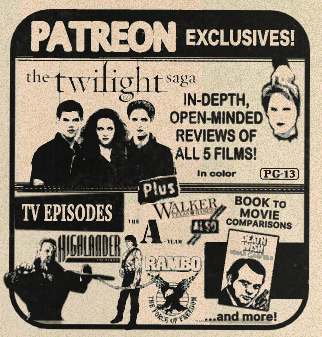

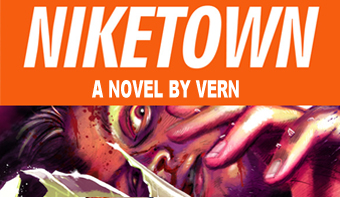
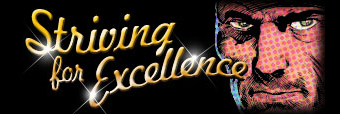
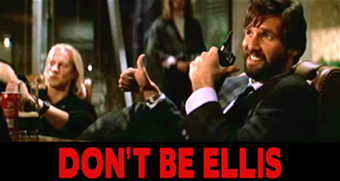











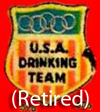







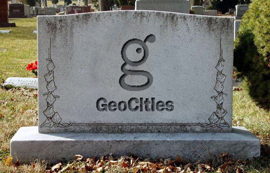
February 10th, 2022 at 1:47 pm
I was in college in the late 1990s, and one of my film professors claimed that Dark City was the fastest-cut narrative feature ever made (to that point in time). He would routinely calculate the average shot length for every movie he’d see, so I believed him. He said it was even faster than Blade!
I liked this one alright when I saw it on initial release, but they really should’ve let Ray Walston reprise the role of Mr. Hand.